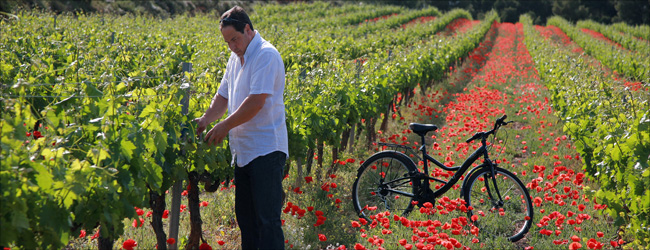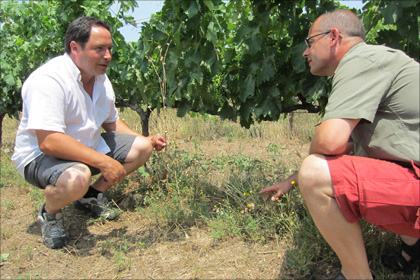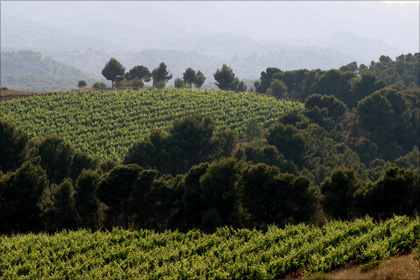We are sorry, this page has not been translated yet.
Osoti Viñedos Ecológicos

Vintner Francisco Ruiz's sense of romanticism: He parks his old bike directly in the blooming poppy field of the vineyards.
In addition to the traditional Crianza, Reserva or Gran Reserva, wines have been created in La Rioja in recent years that are no longer defined by the time spent in oak barrels but by their style. In the north of Spain, a new type of Rioja is being produced with traditional grape varieties, which is notable for its intense mellow fruitiness.
Modern classics
The pioneers of this new style include the red wines of Osoti. They beguile the drinker with aromas of berries and spices and a silky opulence on the palate. Tempranillo is the dominant grape variety. It forms the backbone of the wines and gives them a broad spectrum of aromas. Garnacha, a well-known and increasingly popular variety, is the perfect complement. And slightly in the background, there is Graciano. This well-defined, deep-red variety, rich in tannins, is often used for rounding off the wines. The wines get the finishing touches in a maturation phase in barriques, most of which are made of French Allier oak and American oak.

The Rioja Baja, the southernmost and warmest region of the Rioja, offers optimum conditions for full-bodied wines. On the left: Francisco Ruiz Gutiérrez, on the right: David Rodriguez, buyer at Delinat.
The fact that more consideration is again given to the Garnacha is down to the sunny climate of the Rioja Baja. Here, in the area of influence of the most important river, the Ebro, winemaker Francisco Ruiz Gutiérrez has planted a few new plots with Garnacha tinta.
The bodega’s vineyards are in hilly locations around the small wine-producing town of Aldeanueva de Ebro. The terroir is comprised of loamy soils with a high proportion of chalk as well as rocky strata. While many winegrowers in the Rioja region push the permitted maximum quantities to the limit, Francisco goes for lower yield and more quality.

The predominant grape variety in the Rioja region is the Tempranillo. It covers 61% of the 53,000 hectares. The other important varieties are Garnacha, Mazuelo (Cariñena) and Graciano.
Biodiversity in the vineyards is of particular concern to him. Long before the international year of biodiversity was announced, Francisco was planting aromatic herbs and shrubs between his vines. For years, he has permitted spontaneous vegetation to optimise their growth. His latest project: He is starting to reforest some barren areas around his plots together with a tree nursery.
In themselves and viewed from outside, these measures may seem insignificant. Overall, however, these are important steps with the aim of achieving balanced and sustainable viticulture. Francisco is convinced that the wines also benefit from it.

